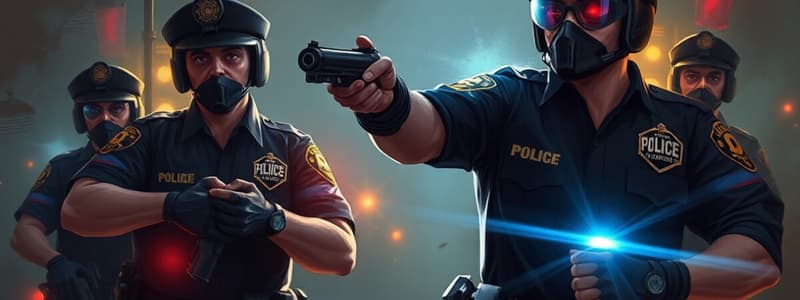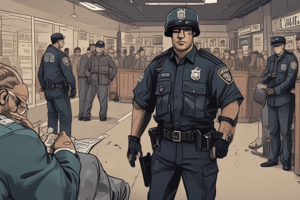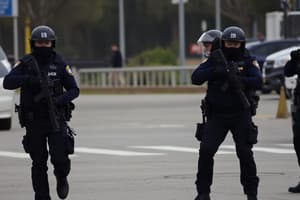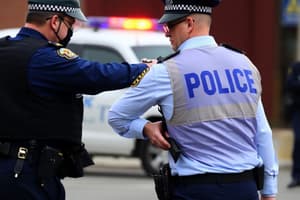Podcast
Questions and Answers
What is the Omaha Police Department's highest priority regarding the use of force?
What is the Omaha Police Department's highest priority regarding the use of force?
- The sanctity of human life and preservation of life for all persons involved. (correct)
- Maintaining public order regardless of the level of force required.
- Ensuring officer safety above all other concerns.
- Apprehending criminal offenders efficiently.
What is the primary goal of the OPD regarding subjects' compliance?
What is the primary goal of the OPD regarding subjects' compliance?
- To gain subjects’ _voluntary_ compliance, when consistent with personal safety, to eliminate or reduce the need for force. (correct)
- To use the minimum amount of force necessary.
- To assert authority and control over all situations encountered.
- To ensure the safety of the officers involved.
Under what circumstances does the OPD acknowledge that officers may need to make split-second decisions about the use of force?
Under what circumstances does the OPD acknowledge that officers may need to make split-second decisions about the use of force?
- During planned operations with pre-determined use-of-force protocols.
- In situations that are tense, uncertain, and rapidly evolving. (correct)
- When there is a clear threat to public property.
- When dealing with non-violent offenders resisting arrest.
According to the OPD policy, what principle must always take precedence over the apprehension of criminal offenders?
According to the OPD policy, what principle must always take precedence over the apprehension of criminal offenders?
What are OPD officers expected to do concerning unreasonable force incidents they observe?
What are OPD officers expected to do concerning unreasonable force incidents they observe?
What is the guiding principle when determining whether a use of force is reasonable?
What is the guiding principle when determining whether a use of force is reasonable?
According to OPD policy, which of the following is NOT a factor when considering the appropriate use of force?
According to OPD policy, which of the following is NOT a factor when considering the appropriate use of force?
An officer witnesses another officer using force against a suspect who has already been fully restrained and is no longer resisting. According to OPD policy, what action should the first officer take immediately?
An officer witnesses another officer using force against a suspect who has already been fully restrained and is no longer resisting. According to OPD policy, what action should the first officer take immediately?
Which of the following best describes an 'Assaultive/High-Risk Subject' interaction?
Which of the following best describes an 'Assaultive/High-Risk Subject' interaction?
What is the primary purpose of an impact weapon according to the provided content?
What is the primary purpose of an impact weapon according to the provided content?
According to the content, what is a 'less-lethal' weapon?
According to the content, what is a 'less-lethal' weapon?
In the context of officer responses, what does 'Empty Hand Techniques (Vital Targets)' refer to?
In the context of officer responses, what does 'Empty Hand Techniques (Vital Targets)' refer to?
What physiological effect does a Vascular Neck Restraint (VNR) aim to achieve?
What physiological effect does a Vascular Neck Restraint (VNR) aim to achieve?
Under what circumstances are officers justified in using deadly force, according to the content?
Under what circumstances are officers justified in using deadly force, according to the content?
An officer is facing a subject who is exhibiting assaultive behavior but has not yet caused serious bodily harm. According to OPD guidelines can the officer use techniques/weapons from a higher subject category?
An officer is facing a subject who is exhibiting assaultive behavior but has not yet caused serious bodily harm. According to OPD guidelines can the officer use techniques/weapons from a higher subject category?
Consider a scenario where an officer is dealing with a suspect who presents an immediate threat of serious bodily injury to others. The officer has a clear shot, but discharging their firearm might also endanger bystanders. According to the use of force options, what considerations should the officer prioritize? (Insanely difficult)
Consider a scenario where an officer is dealing with a suspect who presents an immediate threat of serious bodily injury to others. The officer has a clear shot, but discharging their firearm might also endanger bystanders. According to the use of force options, what considerations should the officer prioritize? (Insanely difficult)
What is the primary goal of de-escalation techniques as defined by the OPD?
What is the primary goal of de-escalation techniques as defined by the OPD?
According to OPD policy, what is the responsibility of an officer who witnesses another officer using objectively unreasonable force?
According to OPD policy, what is the responsibility of an officer who witnesses another officer using objectively unreasonable force?
Which of the following actions must an OPD officer take if they intervene in or witness a fellow officer's use of excessive force?
Which of the following actions must an OPD officer take if they intervene in or witness a fellow officer's use of excessive force?
What is the BEST definition of 'First-Aid' according to the provided material?
What is the BEST definition of 'First-Aid' according to the provided material?
Which of the following BEST describes 'Force'?
Which of the following BEST describes 'Force'?
What is the defining characteristic of 'Less-Lethal Force'?
What is the defining characteristic of 'Less-Lethal Force'?
Which of the following areas is GENERALLY considered a 'Low Lethality Target Area'?
Which of the following areas is GENERALLY considered a 'Low Lethality Target Area'?
What does 'Objectively Reasonable Force' refer to?
What does 'Objectively Reasonable Force' refer to?
What is the standard established in Graham v. Connor that governs an officer's use of force?
What is the standard established in Graham v. Connor that governs an officer's use of force?
What constitutes 'Serious Bodily Injury' as defined in the provided material?
What constitutes 'Serious Bodily Injury' as defined in the provided material?
Striking which of the following areas of the body would be considered to have a high risk of causing serious bodily injury?
Striking which of the following areas of the body would be considered to have a high risk of causing serious bodily injury?
What is the OPD's highest priority in all aspects of officer conduct?
What is the OPD's highest priority in all aspects of officer conduct?
Under what circumstances does the OPD permit the use of improvised techniques and weapons?
Under what circumstances does the OPD permit the use of improvised techniques and weapons?
Why is it important to consider the 'totality of the circumstances' when determining the reasonableness of an officer’s actions?
Why is it important to consider the 'totality of the circumstances' when determining the reasonableness of an officer’s actions?
An officer is on scene and observes a fellow officer use force on a compliant suspect. The suspect is already in handcuffs and verbally complying with all instructions. The first officer does not intervene and fails to file a report about the incident. According to OPD policy, the officer...
An officer is on scene and observes a fellow officer use force on a compliant suspect. The suspect is already in handcuffs and verbally complying with all instructions. The first officer does not intervene and fails to file a report about the incident. According to OPD policy, the officer...
Under what circumstances is a supervisor required to respond to an incident scene?
Under what circumstances is a supervisor required to respond to an incident scene?
According to the guidelines, what is the primary consideration for officers when using less-lethal techniques?
According to the guidelines, what is the primary consideration for officers when using less-lethal techniques?
Which of the following actions is expressly prohibited for officers?
Which of the following actions is expressly prohibited for officers?
When are officers permitted to use deadly force against individuals?
When are officers permitted to use deadly force against individuals?
In what situation can deadly force be used to make a lawful arrest?
In what situation can deadly force be used to make a lawful arrest?
According to the policy, what should officers attempt before using a firearm or other deadly force?
According to the policy, what should officers attempt before using a firearm or other deadly force?
Under what specific circumstance may an officer discharge a firearm at or from a moving vehicle?
Under what specific circumstance may an officer discharge a firearm at or from a moving vehicle?
What does the policy state regarding the use of warning shots?
What does the policy state regarding the use of warning shots?
When an officer response technique proves ineffective after repeated attempts, what should officers consider?
When an officer response technique proves ineffective after repeated attempts, what should officers consider?
Which of the following best describes a cooperative interaction with a subject?
Which of the following best describes a cooperative interaction with a subject?
What is the guiding principle for an officer's response to a subject's behavior?
What is the guiding principle for an officer's response to a subject's behavior?
According to the policy, what factor determines the use of deadly force for officers, regardless of the intended target's age or gender?
According to the policy, what factor determines the use of deadly force for officers, regardless of the intended target's age or gender?
Which of the following is NOT an example of a cooperative subject officer response?
Which of the following is NOT an example of a cooperative subject officer response?
A subject who fails to place their hands behind their back for handcuffing, but offers no other physical resistance, is considered:
A subject who fails to place their hands behind their back for handcuffing, but offers no other physical resistance, is considered:
In addition to self-defense, under what other specific circumstance are officers authorized to use a firearm?
In addition to self-defense, under what other specific circumstance are officers authorized to use a firearm?
Which officer response is appropriate for a passively resistive subject?
Which officer response is appropriate for a passively resistive subject?
According to NRS §28-1412, which condition must ALL be met to justify the use of deadly force to make a lawful arrest?
According to NRS §28-1412, which condition must ALL be met to justify the use of deadly force to make a lawful arrest?
An officer encounters a dog mauling a child. No other means are available to stop the attack. What action does policy authorize?
An officer encounters a dog mauling a child. No other means are available to stop the attack. What action does policy authorize?
Which of the following actions would classify a subject as 'Actively Resistive'?
Which of the following actions would classify a subject as 'Actively Resistive'?
An officer observes a subject clenching their fists and adopting a fighting stance, though no overt threats are made. How should this subject be classified?
An officer observes a subject clenching their fists and adopting a fighting stance, though no overt threats are made. How should this subject be classified?
An officer responds to a call where an individual is threatening self-harm with a knife but makes no threats toward the officer or others. According to policy, can the officer use deadly force?
An officer responds to a call where an individual is threatening self-harm with a knife but makes no threats toward the officer or others. According to policy, can the officer use deadly force?
Which of the following officer responses is LEAST appropriate for an actively resistive subject?
Which of the following officer responses is LEAST appropriate for an actively resistive subject?
An officer is pursuing a fleeing suspect wanted for a non-violent property crime. The suspect evades the officer by running into a crowded shopping mall food court. The officer believes the suspect will likely avoid capture due to the large crowd. Can the officer discharge their firearm into the food court to stop the suspect?
An officer is pursuing a fleeing suspect wanted for a non-violent property crime. The suspect evades the officer by running into a crowded shopping mall food court. The officer believes the suspect will likely avoid capture due to the large crowd. Can the officer discharge their firearm into the food court to stop the suspect?
What is the primary intended purpose of an Electronic Control Device (ECD)?
What is the primary intended purpose of an Electronic Control Device (ECD)?
When deploying a chemical agent, what physiological effects should officers anticipate?
When deploying a chemical agent, what physiological effects should officers anticipate?
What is the main purpose of Pepperball as a direct impact device?
What is the main purpose of Pepperball as a direct impact device?
In what scenario are officers specifically required to articulate in the Chief's Report why lesser officer response options were ineffective against Actively Resistive Subjects?
In what scenario are officers specifically required to articulate in the Chief's Report why lesser officer response options were ineffective against Actively Resistive Subjects?
An officer is attempting to handcuff a subject who is verbally refusing but not physically resisting. The officer has already given clear, lawful orders. According to the principles of graduated response, what should the officer do NEXT?
An officer is attempting to handcuff a subject who is verbally refusing but not physically resisting. The officer has already given clear, lawful orders. According to the principles of graduated response, what should the officer do NEXT?
A subject is running through a crowded marketplace. They ignore all verbal commands to stop and are creating a significant risk of injury to others. Which of the following officer responses would be MOST appropriate, assuming all are available and permissible by policy?
A subject is running through a crowded marketplace. They ignore all verbal commands to stop and are creating a significant risk of injury to others. Which of the following officer responses would be MOST appropriate, assuming all are available and permissible by policy?
An officer is dealing with a suspect who is passively resisting. The suspect is limp and refusing to move, but not struggling or fighting. The officer attempts a joint lock technique, however, due to the suspect's unusual flexibility (hypermobility), the technique is ineffective and appears to be causing the suspect pain without achieving compliance. What is the MOST ethically sound and tactically wise course of action for the officer?
An officer is dealing with a suspect who is passively resisting. The suspect is limp and refusing to move, but not struggling or fighting. The officer attempts a joint lock technique, however, due to the suspect's unusual flexibility (hypermobility), the technique is ineffective and appears to be causing the suspect pain without achieving compliance. What is the MOST ethically sound and tactically wise course of action for the officer?
Flashcards
OPD's Highest Priority
OPD's Highest Priority
Placing human life above all else in police actions.
Impact of Excessive Force
Impact of Excessive Force
Inappropriate force erodes trust and harms community relationships.
Goal of Voluntary Compliance
Goal of Voluntary Compliance
Officers should aim for voluntary cooperation to minimize or avoid force.
Split-Second Decisions
Split-Second Decisions
Signup and view all the flashcards
Priority: Protecting Life
Priority: Protecting Life
Signup and view all the flashcards
Reasonable Force
Reasonable Force
Signup and view all the flashcards
De-escalation Techniques
De-escalation Techniques
Signup and view all the flashcards
Deadly Force
Deadly Force
Signup and view all the flashcards
Individual Response Differences
Individual Response Differences
Signup and view all the flashcards
Cooperative Interactions
Cooperative Interactions
Signup and view all the flashcards
Cooperative Subjects
Cooperative Subjects
Signup and view all the flashcards
Professional Presence
Professional Presence
Signup and view all the flashcards
Non-Verbal Directions
Non-Verbal Directions
Signup and view all the flashcards
Verbal Commands
Verbal Commands
Signup and view all the flashcards
Control, Handcuff, Search
Control, Handcuff, Search
Signup and view all the flashcards
Passively Resistive Subjects
Passively Resistive Subjects
Signup and view all the flashcards
Control Holds/Techniques
Control Holds/Techniques
Signup and view all the flashcards
Strength Techniques
Strength Techniques
Signup and view all the flashcards
Pressure Points/Joint Locks
Pressure Points/Joint Locks
Signup and view all the flashcards
Actively Resistive Subjects
Actively Resistive Subjects
Signup and view all the flashcards
Empty Hand Techniques
Empty Hand Techniques
Signup and view all the flashcards
Electronic Control Device (ECD)
Electronic Control Device (ECD)
Signup and view all the flashcards
Chemical Agent
Chemical Agent
Signup and view all the flashcards
Assaultive/High-Risk Subjects
Assaultive/High-Risk Subjects
Signup and view all the flashcards
Impact Weapon
Impact Weapon
Signup and view all the flashcards
Less-Lethal Weapons
Less-Lethal Weapons
Signup and view all the flashcards
Empty Hand Techniques (Vital Targets)
Empty Hand Techniques (Vital Targets)
Signup and view all the flashcards
Vascular Neck Restraint (VNR)
Vascular Neck Restraint (VNR)
Signup and view all the flashcards
Life-Threatening/Serious Bodily Injury Subjects
Life-Threatening/Serious Bodily Injury Subjects
Signup and view all the flashcards
Firearms
Firearms
Signup and view all the flashcards
Officer Response Hierarchy
Officer Response Hierarchy
Signup and view all the flashcards
De-escalation
De-escalation
Signup and view all the flashcards
Duty to Intervene
Duty to Intervene
Signup and view all the flashcards
Duty to Report
Duty to Report
Signup and view all the flashcards
First-Aid
First-Aid
Signup and view all the flashcards
Force
Force
Signup and view all the flashcards
Involved Officer
Involved Officer
Signup and view all the flashcards
Less-Lethal Force
Less-Lethal Force
Signup and view all the flashcards
Low Lethality Target Areas
Low Lethality Target Areas
Signup and view all the flashcards
Objectively Reasonable Force
Objectively Reasonable Force
Signup and view all the flashcards
Reasonable Belief
Reasonable Belief
Signup and view all the flashcards
Serious Bodily Injury
Serious Bodily Injury
Signup and view all the flashcards
Vital Target Areas
Vital Target Areas
Signup and view all the flashcards
Sanctity of human life
Sanctity of human life
Signup and view all the flashcards
Use De-escalation
Use De-escalation
Signup and view all the flashcards
Evaluate Circumstances
Evaluate Circumstances
Signup and view all the flashcards
Multiple Officer Response Protocol
Multiple Officer Response Protocol
Signup and view all the flashcards
Authorized Use of Less-Lethal Force
Authorized Use of Less-Lethal Force
Signup and view all the flashcards
Choke Holds Prohibition
Choke Holds Prohibition
Signup and view all the flashcards
Deadly Force Justification
Deadly Force Justification
Signup and view all the flashcards
Restrictions on Deadly Force (Self-Harm)
Restrictions on Deadly Force (Self-Harm)
Signup and view all the flashcards
Verbal Warnings Before Deadly Force
Verbal Warnings Before Deadly Force
Signup and view all the flashcards
Deadly Force for Arrest Justification
Deadly Force for Arrest Justification
Signup and view all the flashcards
Risk to Innocent Persons
Risk to Innocent Persons
Signup and view all the flashcards
Fleeing Felon Rule Clarification
Fleeing Felon Rule Clarification
Signup and view all the flashcards
Firearm Use for Alarm/Assistance
Firearm Use for Alarm/Assistance
Signup and view all the flashcards
Firearm Use - Animals
Firearm Use - Animals
Signup and view all the flashcards
Deadly Force - No Discrimination
Deadly Force - No Discrimination
Signup and view all the flashcards
Firearm Discharge at/from Vehicles
Firearm Discharge at/from Vehicles
Signup and view all the flashcards
Warning Shots Prohibition
Warning Shots Prohibition
Signup and view all the flashcards
Unnecessary Exhibition of Weapons
Unnecessary Exhibition of Weapons
Signup and view all the flashcards
Study Notes
- The Omaha Police Department (OPD) prioritizes human life above all else.
- OPD officers must prioritize the preservation of life and safety of everyone involved in any situation.
- Excessive force damages public trust and partnerships.
- Officers can use force to protect public welfare, apprehend offenders, protect life and property.
- Officers should aim for voluntary compliance, using de-escalation when possible.
- Officers often make split-second decisions in tense situations.
- Protecting innocent life takes priority over apprehending offenders.
Policy
- Officers should use objectively reasonable force to control a situation while protecting themselves and others.
- During potential use of force situations, officers will use de-escalation techniques.
- Officers have a duty to intervene during unreasonable force incidents and report them to a supervisor.
- Balancing individual rights against governmental interests determines if a use of force if reasonable.
- Officers have the right to self-defense and a duty to protect others.
Definitions
- Deadly Force: Force that is likely to cause death or serious bodily harm.
- De-escalation: Slowing down incidents to allow for more time and tactical flexibility.
- Duty to Intervene: Obligation to stop a fellow officer from using excessive force when able.
- Duty to Report: Obligation to report observations of excessive force incidents to a supervisor and document the incident on a Chief’s Report (OPD Form 214).
- First-Aid: Short-term treatment given to an ill or injured person before medical aid is obtained.
- Force: Physical effort to control, restrain, or overcome a subject's resistance.
- Involved Officer: An officer who uses force or discharges a weapon that results in serious bodily injury or death of a subject.
- Less-Lethal Force: Any use of force not considered deadly force.
- Low Lethality Target Areas: Parts of the body where strikes pose a low risk of serious injury, such as motor nerve points, soft tissue areas, pit of the abdomen, and extremities.
- Objectively Reasonable Force: Force a reasonable officer would use in similar circumstances based on Graham v. Connor.
- Reasonable Belief: A belief held by a reasonably prudent officer based on known facts.
- Serious Bodily Injury: Injury that creates a substantial risk of death, permanent disfigurement, or long-term loss or impairment of function.
- Vital Target Areas: Areas of the body that when struck have a high risk of causing serious bodily injury, including the midline of the neck, the spine, the sternum, the groin, the joints, the kidneys, and certain areas of the head.
Procedure: Officer Priorities, Variables, and Options
- The OPD's top priority is the sanctity of human life.
- Officers must prioritize the preservation of human life and safety.
- Officers should use de-escalation when safe and when time and circumstances permit.
- Officers will render aid to injured subjects and request medical assistance.
- Officers should maintain ethical behavior and professional conduct.
- Evaluation of force is based on the totality of the circumstances.
- Factors include crime seriousness, level of threat, and immediate danger.
- Improvised techniques/weapons may be reasonable during uncertain confrontations.
- Excessive or unwarranted force is prohibited and will not be tolerated.
- Officers must intervene when a fellow officer uses unreasonable force.
- Supervisors should respond to incidents requiring multiple officers.
- If available, the area sergeant will act as a third responder.
Authorization
- Officers use discretion in choosing less-lethal options.
- Officers can use approved techniques/equipment to:
- Protect themselves/others from harm
- Restrain a resistant individual
- Control an unlawful situation
- Choke holds are prohibited.
Defense of Life
- Officers may use deadly force to defend against imminent threats of death/serious injury.
- Deadly force is prohibited against individuals who only pose a danger to themselves, unless they also endanger officers or others.
- Officers should give verbal warnings before using deadly force, if possible.
Use of Deadly Force to Make a Lawful Arrest
- Deadly force for arrests is limited to the following conditions per NRS §28-1412:
- The arrest is for a felony.
- The person making the arrest is a peace officer or assisting one.
- The officer believes the force creates no substantial risk to innocent persons.
- The crime involved use/threat of deadly force, OR there is substantial risk of death/serious harm if apprehension is delayed.
- A fleeing felon isn't presumed to pose an immediate threat if apprehension is delayed.
- Officers should give verbal warnings before using deadly force, if possible.
Use of Firearms
- Officers can use firearms to:
- Give alarm/call for assistance when no other means is available
- Kill dangerous/severely injured animals
- No distinction will be made based on age/gender when employing deadly force.
- The only guideline for employing deadly force in defense of self or others is whether or not an imminent threat of death or serious bodily harm is present.
- Officers can't discharge firearms at/from moving vehicles unless:
- A person in the vehicle is threatening deadly force
- The vehicle is used as a weapon for mass casualty
- The officer can't retreat
- A moving vehicle doesn't presumptively constitute a deadly threat.
- Officers should avoid shooting at vehicles/occupants and move out of the vehicle's path.
- Caution should be used to avoid injuring bystanders.
- Warning shots are prohibited.
- Unnecessary exhibition of weapons is forbidden.
Use of Force Subject Categories and Officer Responses
- Five subject types: officers' responses must be appropriate to the subject's behavior.
- Officer's response may be lower than responses listed for the subject category.
- The least amount of force necessary to control the subject must be used by the officer.
- Not everyone responds to use of force/pain compliance in the same manner.
- Aternative officer response techniques or methods, including de-escalation, should be used when any response technique does not appear to be effective.
Cooperative Subjects
- Interactions involve achieving a goal without physical force.
- Subjects respond positively to presence and verbal commands.
- Subjects allow control or searching to take place with no resistance.
- Officer responses:
- Professional presence
- Non-verbal directions/commands
- Verbal commands
- Control, handcuff, search
Passively Resistive Subjects
- Subjects fail to follow lawful orders.
- Officer responses to passively resistive subjects:
- Control Holds and Leverage Techniques
- Strength Techniques
- Pressure Points/Joint Locks
Actively Resistive Subjects
- Subjects physically impede an officer's control.
- Actions that can occur: running away, pulling away, flailing, or hiding.
- Posing a stance that would reasonably indicate that the subject will physically resist efforts to secure, control, or handcuff the subject.
- Officer responses to actively resistive subjects:
- Empty Hand Techniques (Low Lethality Targets)
- ECD (Electronic Control Device)
- Chemical Agent
- Pepperball Launcher
- Takedown Techniques
- Canine (K-9)/Police Service Dog (PSD)
- Impact Weapons
Assaultive/High-Risk Subjects
- Involves threats or attempts to harm officers/others.
- Likelihood of injury exists.
- Officer responses to assaultive/high-risk subjects:
- Impact Weapons
- Less-Lethal Weapons
- Empty Hand Techniques (Vital Targets)
- Vascular Neck Restraint (VNR)
Life-Threatening/Serious Bodily Injury Subjects
- Actions likely to cause serious injury/death.
- Justifies deadly force in self-defense/defense of others.
- Officer responses:
- Firearms
- Impact Weapon strikes to Vital Target Areas
- Vascular Neck Restraint (VNR)
OPD Officers’ Use of Force Options
- Officers may use illustrated techniques/weapons to control subjects.
- Responses may include techniques/weapons from a lower subject category than the current subject interaction.
- Responses will not include techniques/weapons from a higher subject category than the current subject interaction.
Studying That Suits You
Use AI to generate personalized quizzes and flashcards to suit your learning preferences.




